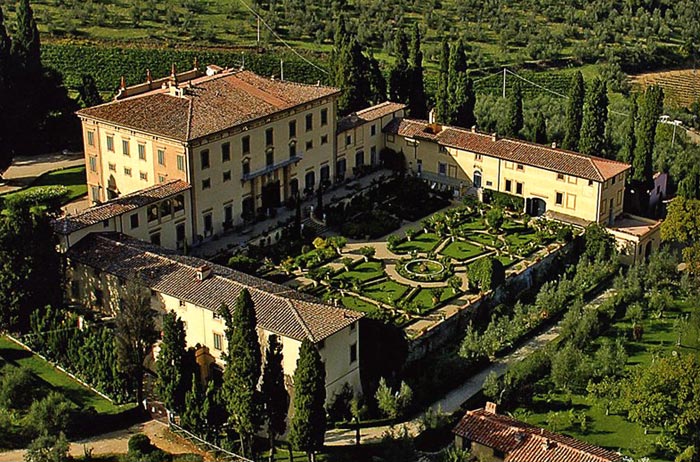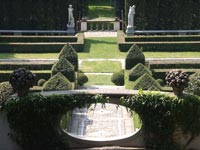| |
|
| The Villa Poggio Torselli is situated just outside San Casciano Val di Pesa, immersed in the greenery of vineyards and olive groves, and was recorded in the land registers as early as the beginning of the 15 C. It is traversed by a monumental boulevard of cypresses and boasts an extraordinary panorama across a typical landscape of the Tuscan hills.
|
The villa is one of the largest and most elegant residences in the area of the San Casciano Hills, near Florence. Known in the past as the queen of all villas, it appeared on record as early as 1427 bearing the name of Poggio Torselli. It was the property of some of the most remarkable patrician families in Tuscany: Macchiavelli, Corsini, Strozzi, Antonori, Capponi and Orlandini, who owned the villa until 1722. The villa's prestigious status drew many important figures, among whom Pope Pius VII - who stopped over on his way to Paris to crown Emperor Napoleon in 1804 - and Paul I, Emperor of Russia. Today the villa is a national monument.
The estate experienced both peaceful and troubled times. Works to construct the modern villa began at the end of the 17th century and were completed in the early 18th century by Lorenzo Merlini, a professional builder who was very popular with the Florentine nobility of the period. [1] The building consists of a central block and two “L-shaped”wings housing apartments, offices, the chapel and the lemon-house; tothe south, the wings enclose a beautiful Italian style garden. It is built in the sober and elegant Florentine architectural style.
Ornamental waterworks, flower beds, hedges, an alternation of views and heights:the Villa’s garden. Respecting the original 18thcentury layout of the garden, the typical plants of that period have been planted and the original irrigation system made out of stone – one of the bestpreserved in Tuscany – has been restored. The garden maintains its charm all year round thanks to the rotation of seasonal plants:old roses, aromatic plants, annuals, perennials.
The "Season s' Garden", created in the 18th century offers the most astonishing image of its rebirth in April, with the scented blossom of the splendid bulbous plants: narcissus, tulips, hyacinths and many others spring plants such as, in particular, the firittilaria also known as "imperial crown" because of the orange tuft of bell-shaped, pendolous flowers surmounting the bottom of the stem that, thanks to its charme deserved one of the most clamorous nobilty's title of Villa Poggio Torselli. But, not less perfumed and gorgeous is the exotic summer of the garden, crowned by plants of dahlia, sage, multicolour clematis and Indian giant ibiscus. And, in every season, the entire garden is surrounded by the golden crown of 120 secular lemon trees.
|
|
|
|
| |
|
Villa Poggio Torselli
Via Scopeti, 10
50026 San Casciano in val di Pesa
Web site Villa Poggio Torselli | www.poggiotorselli.it

[1] ' Lorenzo Merlini (b Florence, 13 May 1666; d Rome, after 1739). Italian sculptor, medallist, miniaturist and architect. He came from a family of craftsmen and, like his father, trained in the grand ducal workshops in Florence. He then worked for the Medici court. His emergence as a sculptor dates to c. 1692, with his two marble Angels for the Ferroni Chapel (Florence, SS Annunziata). In November 1694 he moved to Rome, where for about a year he was active as a medallist and miniaturist. For the altar in the chapel of St Ignatius in the church of Il Ges?, Rome, Merlini executed a bronze relief of St Peter Appearing to St Ignatius (1695-6), based on a drawing by Andrea Pozzo, and Two Putti Flanking a Cartouche (1697). His monument to the Marchesa Riccardi (c. 1700; Rome, S Giovanni dei Fiorentini), which demonstrates his fine abilities as a portrait artist in the manner of Lorenzo Ottoni, is the most significant work of his first stay in Rome. Returning to Florence in 1702, Merlini was active as an architect at the Villa Orlandini at Poggio Torselli and at the Villa Acciaioli at Monte Grufoni. He also designed the extension to the Palazzo Dati and the reconstruction of the Palazzo Bagnano, both in Florence. For the Orlandini Chapel in S Maria Maggiore, Florence, he sculpted Purity and Innocence (both in situ).'
From Art in Tuscany | Lorenzo Merlini

Artist and writer's residency | Podere Santa Pia
|
|
|
|
|
|
|
|
|
|
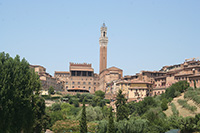
|
Podere Santa Pia |
|
Podere Santa Pia, view from the garden
on the valley below
|
|
|
| |
|
|
|
|

Villa Medicea La Petraia
In the first half of XVIth century, the Medici became the owners of this mansion, which then was characterized by a typical medieval design. Following a project by Buontalenti, a good number of modifications were effected, until the works were completed, by the end of the XVIth century. The structure has a square base, it is two stories high and it has maintained the ancient tower.
The entrance is immersed in a wide surrounding garden. These gardens, on three levels, mirror the typical XVIth century layout, although a few modifications were included during the XIXth century From the Italian garden you climb up to the middle fishpond, and then you reach the suspended level of the Figurine, so called because of the fountain depicting Florence’s Venus.
The entrance portal is located on the southern edge, and the symbol of the Medici-Lorena hangs over it. From the hallway you can reach the central court, decorated with frescoes by Daddi and by Volterrano.
The glass coverings in the courtyard, turned into a ballroom, and the Imperial style furnishings in the halls were ordered by Vittorio Emanuele II di Savoia. Among the major elements of interest we will remember the collection of social games (Hall of games) and the small study, hosting a bronze statue by Giambologna.
Once the crowning of the fountain on the Level of the Figurine, the statue depicts Florence’s Venus drying her hair from the waters of Arno and Mugnone. The English park on the hill behind the mansion is also worthy of a visit.
Villa Medicea della Petraia, Castello, Via della Petraia 40, Firenze | (055 452691)
Giardino dei Semplici
The Orto Botanico di Firenze (2.3 hectares), also known as the Giardino dei Semplici, the "Garden of simples",[1] is a botanical garden maintained by the University of Florence. The Botanical Gardens of Florence is one of the oldest Botanical Gardens in the world, together with Padua and Pisa.
The garden was established on December 1, 1545, by Cosimo I de' Medici, Grand Duke of Tuscany, and is Europe's third oldest, behind the Orto Botanico di Pisa and the Orto Botanico di Padova. It was first laid out by landscape gardener Niccolò Pericoli to a botanical system and plantings chosen by Luca Ghini, and rose to prominence under Cosimo III, with Pier Antonio Micheli as its director. As was typical of early European botanical gardens, its prime interest was in medicinal plants. However, as in 1753 the Società Botanica was formed, the garden's focus turned to "experimental agriculture" and its layout was revised accordingly. The garden grounds opened to the public in the mid-19th century, at about the same time that its glass houses (1694 m²) were constructed.
Villa Medici at Fiesole, near Florence, is one of the oldest Renaissance residences with a garden and is also one of the best preserved, but at the same time one of the least well known. While most of the villas dating back to the same period, such as Cafaggiolo and Trebbio, stand at the centre of agricultural concerns, Villa Medici had no connections at all with farming life.
The villa was built during the mid 15th century when Cosimo de' Medici the Elder employed Michelozzo di Bartolomeo to design it for his second son, Giovanni. Intended to be a setting for intellectual life rather than a working Villa, Villa Medici was constructed to be a demonstration of aesthetic and ideological values. It owes its fame to Lorenzo il Magnifico who inherited the property in 1469 following the untimely death of his uncle. The new master of the house turned the residence into a gathering place for artists, philosophers and men of letters such as Marsilio Ficino, Pico della Mirandola and Angelo Ambrogini, known as Poliziano. The quadrangular building is a typical 15 C edifice, with square pietra serena windows and broad loggias looking out over the surroundings.
The villa remained the property of the Medici until 1671.
The geographical position of the villa on gently sloping land suggested the layout of the garden on three terraces. The first of these, at the end of an avenue lined with cypress trees that runs underneath a holm-oak wood, has large rectangular lawns with potted lemon trees. The villa's piano nobile looks out onto this part of the garden. The second terrace is overlooked by the rear of the building and is reached by an indoor staircase. This, the least heavily altered part of the garden, has flower beds lined with box hedges with a large fountain in the centre, and is laid out in the shade of large magnolia trees. The third terrace, created between 1911 and 1923 by Cecil Pinsent and Geoffrey Scott [1] is aligned longitudinally with the first, but is 11-12 m lower down. It is laid out in the Italian style, with a fine pergola positioned mid-way between the two levels. Lady Sybil's daughter and heiress, Iris Origo, later employed Cecil Pinsent for the development of the garden at La Foce, her property in the Crete Senesi near Montepulciano.
The gardens and estate of La Foce constitute one of the most important and best kept early twentieth-century gardens in Italy. Amid 3,500 acres of farmland in the countryside near Pienza, with sweeping views of the Tuscan landscape, La Foce was the childhood dream garden of the late writer Marchesa Iris Origo. Passionate about the order and symmetry of Florentine gardens, Origo and her husband, Antonio, purchased the dilapidated villa in 1924, soliciting the help of English architect and family friend Cecil Pinsent to reawaken the natural magic of the property. Pinsent designed the structure of simple, elegant, box-edged beds and green enclosures that give shape to the Origos' shrubs, perennials, and vines, and created a garden of soaring cypress walks, native cyclamen, lawns, and wildflower meadows. It is, by all accounts, a remarkable achievement.
Situated in the Val d'Orcia, a wide valley in southeastern Tuscany that seems to exist on a larger, wilder scale than the rest of the Tuscan landscape, it is run by Benedetta and Donata Origo, and is open to the public one day a week.
Villa I Tatti
Villa I Tatti in Settignano was home to Bernard Berenson, the Lithuanian Jew who became America's most illustrious critic and connoisseur of Renaissance art. For 50 years it was a mecca for intellectuals and collectionists from the world over. Today the art collection and library serve as a research facility for Harvard University.
In 1900, Bernhard Berenson bought a villa in the Tuscan hills of Settignano, outside Florence. Villa I Tatti subsequently would be forever associated with Berenson. The gardens of the Villa I Tatti were created by the English landscape architect Cecil pinsent and Geoffrey Scott.
The newly married art historians Bernard and Mary Berenson made their home at the Villa I Tatti near Florence in 1900. In the following years Mary, supervised the rebuilding of the villa and the creation of its elegant gardens. The Berensons pursued their work at I Tatti over a period of nearly six decades, and here they entertained a remarkable circle of friends :art historians ( Kenneth Clark, John Walker, John Pope-Hennessy), writers (Edith Wharton, Alberto Moravia), political thinkers (Walter Lippman, Gaetano Salvermini), musicians (Yehudi Menuhin) and countless other visitors from every part of the world. At I Tatti Bernard Berenson assmbled a choice collection of Renaissance art, including works by Giotto, Sassetta, Domenico Veneziano, and Lorenzo Lotto. He also formed a prodigious art historical research library and photograph collection. When he died in 1959, he bequeathed the house, its contents, and the gardens to Harvard University as a Center for Renaissance Studies.
|
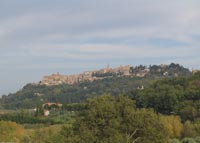 |
|
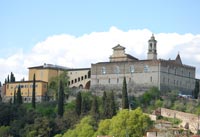 |
|
|
Montepulciano |
|
Certosa del Galluzzo (Firenze) |
|
Villa I Tatti
|
| |
|
|
|
|
The Villa Poggio Torselli is a member of the Grandi Giardini Italiani, an association of major gardens in Italy. Its members include some of the most important gardens in Italy.
List of member gardens
| Fondazione Pompeo Mariani (Imperia), Giardini Botanici di Stigliano (Roma), Giardini Botanici di Villa Taranto (Verbania), Giardini Botanici Hanbury (Ventimiglia), Giardini della Landriana (Roma), Giardini La Mortella (Napoli), Giardino Barbarigo Pizzoni Ardemani (Padova), Giardino Bardini (Firenze), Giardino dell'Hotel Cipriani (Venezia), Giardino di Boboli (Firenze), Giardino di Ninfa (Latina), Giardino di Palazzo del Principe, Giardino di Villa Gamberaia (Firenze), Giardino Ducale di Parma, Giardino Esotico Pallanca (Imperia), Giardino Giusti (Verona), Giardino Storico Garzoni (Pistoia), Gardens of Trauttmansdorff Castle (Merano), Giardino del Biviere (Siracusa), Serraglio di Villa Fracazan Piovene (Vicenza), Vittoriale degli Italiani (Brescia), Cervara, Abbazia di San Girolamo al Monte di Portofino (Genova), Venaria Reale, Museo Giardino della Rosa Antica (Modena), Museo Nazionale di Villa Nazionale Pisani (Venezia), Oasi di Porto (Roma), Orto Botanico dell'Università di Catania, Palazzo Fantini (Forlì), Palazzo Parisio (Malta), Palazzo Patrizi (Roma), Parco Botanico di San Liberato (Roma), Parco del Castello di Miramare (Trieste), Parco della Villa Pallavicino (Verbania), Parco della Villa Reale di Marlia (Lucca), Parco di Palazzo Coronini Cronberg (Gorizia), Parco di Palazzo Malingri di Bagnolo (Cuneo), Parco di Pinocchio (Pistoia), Parco Giardino Sigurtà (Verona), Parco Idrotermale del Negombo (Napoli), Parco Paternò del Toscano (Catania), Parco Storico Seghetti Panichi (Ascoli Piceno), Varramista Gardens (Pisa), Villa Arvedi (Verona), Villa Borromeo Visconti Litta (Milano), Villa Carlotta (Como), Villa del Balbianello (Como), Villa della Porta Bozzolo (Varese), Villa d'Este (Como), Villa d'Este (Tivoli), Villa di Geggiano (Siena), Villa Durazzo (S. Margherita Ligure, GE), Villa Farnese di Caprarola (Viterbo), Villa Grabau (Lucca), Villa La Babina (Imola), Villa La Pescigola (Massa), Villa Lante (Viterbo), Villa Melzi d'Eril (Como), Villa Montericco Pasolini (Imola), Villa Novare Bertani (Verona), Villa Oliva-Buonvisi (Lucca), Villa Peyron al Bosco di Fontelucente (Firenze), Villa Pisani Bolognesi Scalabrin (Padova), Villa Poggio Torselli (Firenze), Villa San Michele (Napoli), Villa Serra (Genova), Villa Trento Da Schio (Vicenza), Villa Trissino Marzotto (Vicenza), Villa Vignamaggio (Firenze).
Grandi Giardini Italiani (Italian) | www.grandigiardini.it |
|
|
